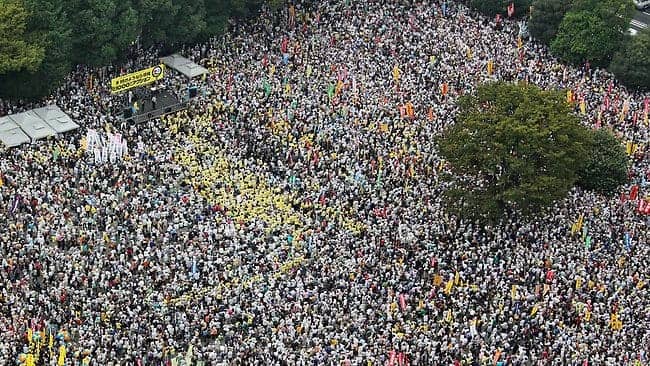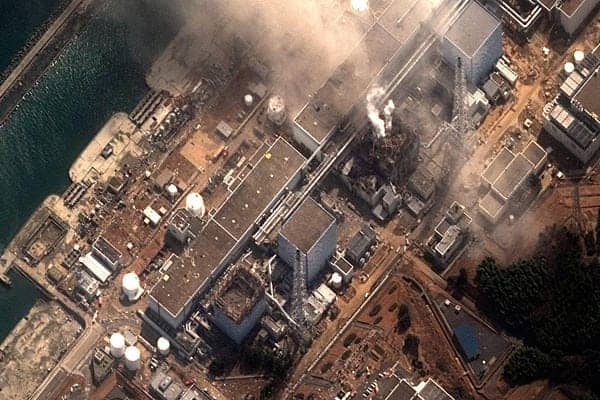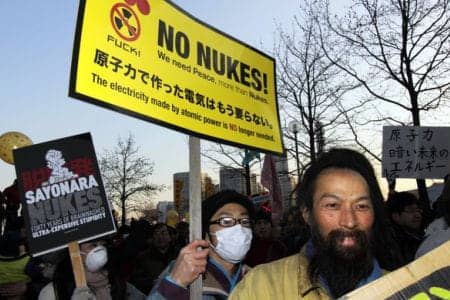by Janette D. Sherman, M.D., and Joseph J. Mangano, M.P.H.

The investigative reporter, Karl Grossman, for his program Envirovideo, interviewed Dr. Sherman on March 5, 2011, and she said that it was just a matter of time before we have another nuclear meltdown. Less than a week later, on March 11, following the earthquake and tsunami in Japan, Fukushima Daiichi did just that. On March 19, Professor Alexey Yablokov, the senior author of “Chernobyl – Consequences of the Catastrophe for People and the Environment,” arrived on a previously planned visit to Washington, D.C. In a series of radio and TV interviews, we opined, even that early, it appeared that Fukushima was worse than Chernobyl – the latter continuing to harm 25 years later.
On March 25, before Professor Yablokov flew to Seattle for a series of talks, Matt Wald of the New York Times interviewed him. In two follow-up emails asking Wald what he planned to do with the interview, Wald wrote on Nov. 7: “I have not published anything on that conversation and I’m not sure I will … I don’t think the thrust of the book has achieved sufficient scientific traction,” and “I don’t believe there’s evidence that human exposures from Fukushima approach those of Chernobyl.”
The stance of the New York Times is not surprising, as a bastion of corporatism, so well explained in Chris Hedges’ book: “Death of the Liberal Class.” Selective blackouts such as this must push citizens to educate themselves – if we do not understand the many adverse effects caused by Chernobyl, how can we prepare for and document the ones surely resulting from Fukushima. If we don’t know the history of Chernobyl, how can we prevent yet more nuclear meltdowns?

The U.S. Center for Disease Control (CDC) reported weekly deaths by age in 122 cities, which represents about 25 to 35 percent of the population total. Deaths rose 4.46 percent from 2010 to 2011 in the 14 weeks after the arrival of Japanese fallout, compared with a 2.34 percent increase in the prior 14 weeks. The number of infant deaths after Fukushima rose 1.80 percent, compared with a previous 8.37 percent decrease. Projecting these figures for the entire United States yields 13,983 total deaths and 822 infant deaths in excess of the expected numbers. ((Mangano, J.J., Sherman, J.D., “An Unexpected Mortality Increase in the United States Follows Arrival of the Radioactive Plume from Fukushima: Is There a Correlation?” International Journal of Health Services, Volume 42, Number 1, pages 47-64, 2012.)) An updated analysis using the entire year 2011 raised the excess deaths to 21,851.
By contrast to nuclear tests that prolong the release of radioisotopes by dispersion into the stratosphere, emissions from nuclear power plants are dispersed at low atmospheric levels, brought down by rain and snow in a matter of days to weeks. Every nuclear power plant releases a number of isotopes, whether it is operating “normally” or melting down. These include Sr-90, Cs-137, I-131, argon, krypton, xenon and barium, taken up by animals, plants and humans.
The epidemic increase in childhood and adult cancer has occurred since World War II, when both chemical and radiological pollution spread over the world. Half a century later, there is no longer any doubt that radioisotopes in concert with industrial chemicals have caused this epidemic. ((Carson, R., “Silent Spring,” 1962, Sherman, J.D., ibid. 2000.))
There is no longer any doubt that radioisotopes in concert with industrial chemicals have caused the epidemic increase in childhood and adult cancer that has occurred since World War II.
All forms of cancer can be induced by radiation. The incidence increases with cumulative dose, and younger aged individuals – human, animals and plants alike – are more sensitive to ionizing radiation than adults. It is not only cancer that is of concern, but genetic damage, birth defects, over-all health and loss of intellectual capacity, the latter absolutely essential for survival. In Belarus, only 20 percent of children are considered well by official standards since the Chernobyl catastrophe.
A unique study of Norwegian children, exposed early before birth to low-level Chernobyl fallout, demonstrated lower intellectual capacity than a comparable group not exposed. ((Sverdvik, K., et al. “Effect of low dose ionizing radiation exposure in utero on cognitive function in adolescence.” Scandinavian Journal of Psychology, Volume 51, Issue 3, pages 210–215, 2010.))

In Belarus, only 20 percent of children are considered well by official standards since the Chernobyl catastrophe.
Studies of mutation rates of plants and animals around Chernobyl have increased by up to a factor 20 due to release of radionuclides. Rare bird species suffered greater impact than more common ones. Given that each slightly deleterious mutation is expected to result in a selective genetic death and that an average fruit fly under normal conditions may carry as many as 80 mutations, the number of mutations in animals and plants around Chernobyl and hence the number of selective deaths is bound to be much higher. ((Moller, A.P., Mousseau, T.A., “Conservation consequences of Chernobyl and other nuclear accidents,” Biological Conservation 144 (2011) 2787-2798.))
Bird populations in Fukushima appear to fare worse than those near Chernobyl. Analysis of 14 species common to the two areas revealed a negative effect of radiation immediately after the March 11, 2011, accident upon abundance, differing between areas and species, during the main breeding season in March to July, when individuals work close to their maximum sustainable level. ((Moller, A.P, et al. “Abundance of birds in Fukushima as judged from Chernobyl,” Environmental Pollution 164: 36-39, 2012.))
The citizens of San Francisco’s Hunters Point neighborhood have long known that factors adversely impacting children, adults and the unborn are emissions from incinerators and dumps, chemicals released from various industrial processes, pesticides and other toxic chemicals. Repeated small exposures to radionuclides and to many industrial and agricultural chemicals produce additive and synergistic effects, resulting in greater toxicity than from a single equivalent dose.
What is to be done?
It is absolutely essential that health and environmental data be compiled and made available to the public in an open and transparent way so that contamination levels are known. This information is needed to anticipate and structure health care for those damaged by the fallout of radioactive isotopes. It is in this context that governments must be able to handle increased disease levels. Given the known fallout of radioactive iodine, it is likely that various thyroid diseases (hypo-, hyper-, non-malignant and malignant disease) will increase, thus testing and treatment must be planned for and available.
But beyond just diagnosing and treating more people with radiation-related disease, we can truly prevent these diseases by closing nuclear power reactors, thus reducing exposure to radiation. This is not a theory, but a reality with precedents. After President John F. Kennedy signed the 1963 treaty banning above-ground atom bomb tests, there was an immediate and drastic decline in U.S. infant deaths and cancer in young children. After the closing of eight U.S. nuclear power plants in the 1980s and 1990s, similar declines occurred in down-wind areas. ((Mangano, et al., “Infant death and childhood cancer reductions after nuclear plant closing in the U.S.,” Archives of Environmental Health, 57(1): 23-32, 2002.))
After President John F. Kennedy signed the 1963 treaty banning above-ground atom bomb tests, there was an immediate and drastic decline in U.S. infant deaths and cancer in young children.
With one in six of our population living within 50 miles of a nuclear reactor, the opportunity for a healthier future is great indeed.
Every remaining nuclear power plant is a disaster waiting to happen. Twenty-three of these in the U.S. are the same design as those that are melting down at Fukushima Daiichi. California’s San Onofre and Diablo Canyon nuclear plants are located on the ocean, next to known earthquake faults, and up-wind of huge populations where evacuation is next to impossible. Indian Point Nuclear Power Plant, on the Hudson River, is 35 miles north of New York City, where it is a threat to one-fifth of the entire U.S. population.

I hope not! Or is it the billions of dollars spent by the U.S. government and the nuclear industry in support of this dangerous and unsustainable industry? Protests against the excesses of Wall Street are taking place – can we mobilize to close all nuclear power plants?
Since the Fukushima disaster, only two of 54 Japanese reactors are operating – the rest closed for inspection and upgrades. Germany and Switzerland have pledged to phase out their reactors, and other nations are considering the same.
Unless the earth stops turning and the laws of chemistry, biology and physics are rescinded, the radioisotopes being released from Fukushima will cause worldwide harm to life. It is in our hands to prevent another Chernobyl or Fukushima.
Dr. Sherman is the contributing editor of “Chernobyl – Consequences of the Catastrophe for People and the Environment,” now available at orders@grekoprinting.com. (Originally costing $150, the authors have reduced the price to $10 so it can be widely acquired and read. – ed.) She can be reached at janettesherman.com. Mr. Mangano is executive director of the Radiation and Public Health Project and can be reached at radiation.org.





